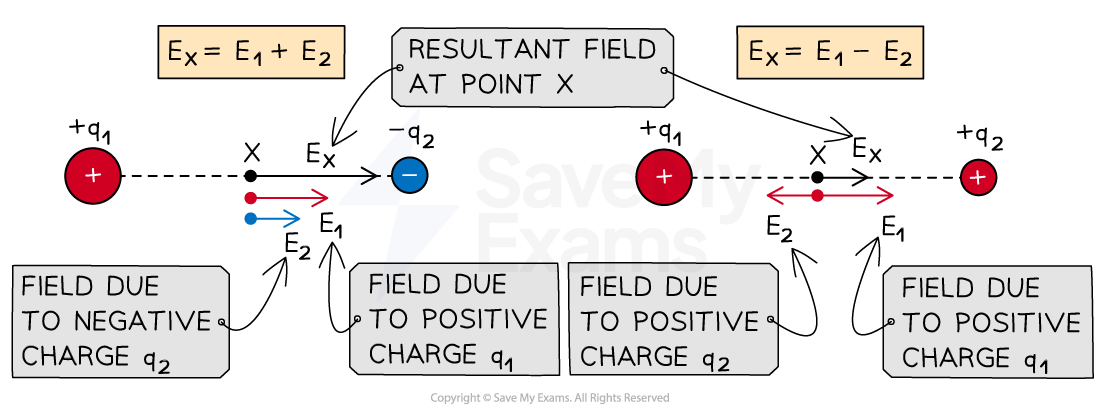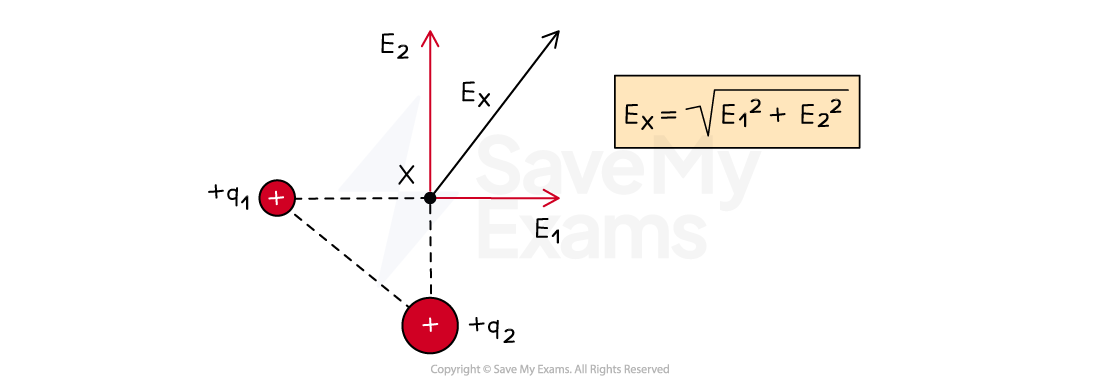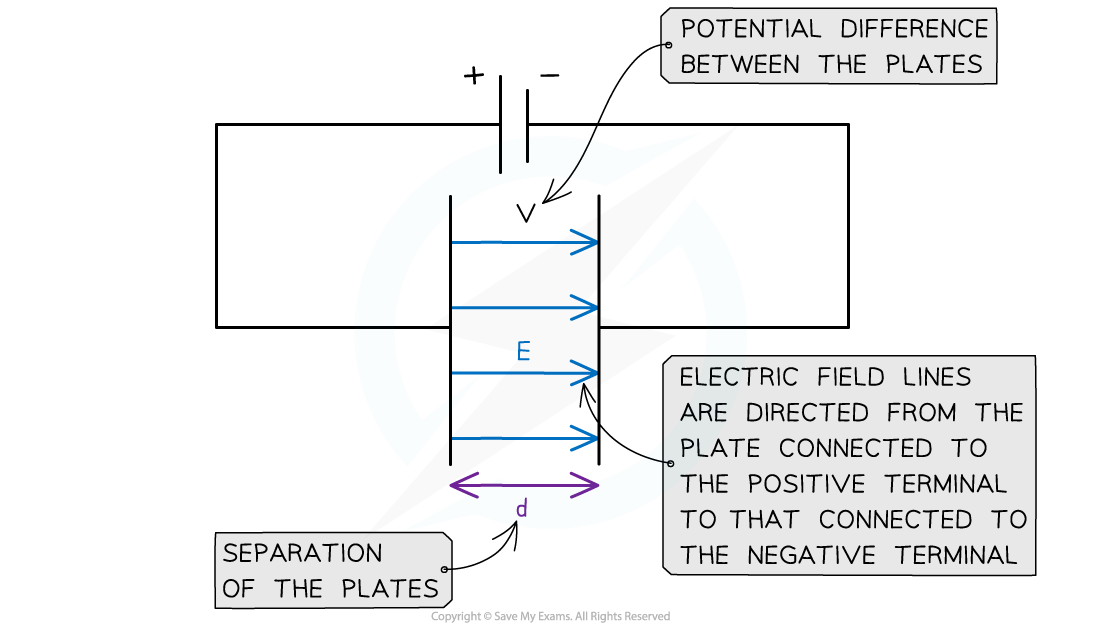Electric Field Strength (DP IB Physics) : Revision Note
Electric Field Strength
An electric field is a region of space in which an electric charge experiences a force
The electric field strength at a point is defined as:
The force per unit charge experienced by a small positive test charge placed at that point
The electric field strength can be calculated using the equation:
Where:
E = electric field strength (N C−1)
F = electric force on the charge (N)
q = magnitude of the charge (C)
Note that the definition specifies that a positive test charge is used
This sets a clear convention for the direction of an electric field, for example, in a field of strength
:
A positive charge
experiences a force
in the direction of the field
A negative charge
experiences a force
in the opposite direction
Hence, electric field strength is a vector quantity and is always directed:
Away from a positive charge
Towards a negative charge
Electric Field Strength due to a Point Charge
The strength of an electric field due to a point charge decreases with the square of the distance
This is an inverse square law, similar to Coulomb's law
Using Coulomb's law, this can be written as
Where k = Coulomb constant (N m2 C–2)
A charged sphere acts the same as a point charge, with the same charge as the sphere, at the sphere's centre
Within the sphere, however, the electric field strength is zero
This means that the electric field of a charged sphere, outside the sphere, is identical to that of a point charge
Graph of field strength against distance for a positive charge

Electric field strength is zero inside a charged sphere and decreases with distance outside the sphere according to an inverse square law
Combining Electric Fields
Both electric force and field strength are vector quantities
Therefore, to find the electric force or field strength at a point due to multiple charges, each field can be combined by vector addition
Vector addition of electric field along the same line

For charges along the same line, the resultant field is the vector addition of the field due to both charges at a particular point
For a point on the same line as two charges q1 and q2, with field strengths E1 and E2 respectively, the magnitude of the resultant field will be:
The sum of the fields, E1 + E2, if they are both in the same direction
The difference between the fields, E1 − E2, if they are in opposite directions
The direction of the resultant field depends on
the types of charge (positive or negative)
the magnitude of the charges
For a point which makes a right-angled triangle with the charges, the resultant field can be determined using Pythagoras theorem
Vector addition of electric field components

For charges which make a right-angle triangle with point X, the resultant field is the vector addition of the field due to both charges using Pythagoras theorem
Worked Example
A charged particle experiences a force of 0.3 N at a point where the magnitude of electric field strength is 3.5 × 104 N C−1.
Calculate the magnitude of the charge on the particle.
Answer:
Step 1: Write down the equation for electric field strength
Step 2: Rearrange for charge Q
Step 3: Substitute in the values and calculate:
C (2 s.f.)
The particle has a charge of 8.6 × 10−6 C or 8.6 μC
Worked Example
A metal sphere of diameter 15 cm is uniformly negatively charged. The electric field strength at the surface of the sphere is 1.5 × 105 V m−1.
Determine the total surface charge of the sphere.
Answer:
Step 1: List the known quantities
Electric field strength, E = 1.5 × 105 V m−1
Radius of sphere, r = 15 / 2 = 7.5 cm = 7.5 × 10−2 m
Coulomb constant, k = 8.99 × 109 N m2 C–2
Step 2: Write down the equation for electric field strength
It is possible to treat the sphere as a point charge with the same total charge, as it is uniformly charged
Step 3: Rearrange for charge Q
Step 4: Substitute in the values and calculate:
C
The sphere has a charge of 9.4 × 10−8 C or 94 nC
Examiner Tips and Tricks
When combining electric fields from multiple charges, remember that the point (e.g. point X in the examples above) represents a positive test charge, so the direction of the electric force or field will correspond to the signs of the charges; the direction of the force or field points away from a positive charge and towards a negative charge.
Electric Field Between Parallel Plates
The magnitude of the electric field strength in a uniform field between two charged parallel plates is defined as:
Where:
E = electric field strength (V m−1)
V = potential difference between the plates (V)
d = separation between the plates (m)
Note: both units for electric field strength, V m−1 and N C−1, are equivalent
The equation shows:
The greater the voltage between the plates, the stronger the field
The greater the separation between the plates, the weaker the field
This equation cannot be used to find the electric field strength around a point charge
This is because the field around a point charge is radial
The electric field between two plates is directed:
From the positive plate (i.e. the one connected to the positive terminal)
To the negative plate (i.e. the one connected to the negative terminal)
Uniform Electric Field Between two Parallel Plates

The electric field strength between two charged parallel plates is the ratio of the potential difference and separation of the plates
Worked Example
Two parallel metal plates separated by 3.5 cm have a potential difference of 7.9 kV between them.
Calculate the electric force acting on a point charge of 2.6 × 10−15 C when placed between the plates.
Answer:
Step 1: List the known quantities
Potential difference between plates, V = 7.9 kV = 7900 V
Distance between plates, d = 3.5 cm = 0.035 m
Charge, q = 2.6 × 10−15 C
Step 2: Equate the equations for electric field strength
E field between parallel plates:
E field on a point charge:
Step 3: Rearrange the expression for electric force F
Step 4: Substitute values to calculate the force on the point charge
N (2 s.f.)
Examiner Tips and Tricks
Remember the equation for electric field strength with V and d is only valid for parallel plates, and not for point charges
However, when a point charge moves between two parallel plates, the two equations for electric field strength can be equated:
Top tip: if one of the parallel plates is earthed, it has a voltage of 0 V

You've read 0 of your 5 free revision notes this week
Sign up now. It’s free!
Did this page help you?
